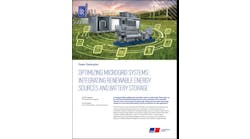Tom Poteet, vice president of corporate development at Mesa Solutions, explains how electric power resilience solutions help organizations bounce back quickly in times of crisis.
“Resilience” applies to many dimensions of operation. In this article, we’re primarily talking about electric power resilience, however, the principles apply to numerous other characteristics of how an organization operates. Including a robust power resilience feature to your organization means there will be a rapid, adequate power standby system on-site when the normal utility service goes down. It could also mean that the site operates on an independent power system 24/7 and isn’t vulnerable to utility grid outages. In either case, if you’ve planned ahead and installed a resilient power solution, your organization will be ready to respond during problematic power scenarios.
Suppose the scenario is something like a regional power outage caused by fire. The region of this outage is large enough to include a significant number of your customers. The outage is expected to last, at the very least, two and a half weeks.
There are three reasons why your planned, resilient organization will respond better than nonresilient organizations:
First, you won’t feel the initial “big hit” your nonresilient competitors are sure to experience. Usual demand for your product or service may drop because your customers aren’t able to get to you or because they currently need less from you, but you’ll still be open, and you’ll still be generating revenue. Plus, you’ll have a component of increased demand from customers that usually took their business elsewhere. Depending on what you do or sell, your demand may go through the roof because you are the only operating provider in the area.
Photo courtesy of Mesa Solutions
Second, whether the overall recovery curve in the area is “U” shaped or “V” shaped, you’ll head back up the curve faster because of momentum. Since you never stopped operating, your business never had to perform layoffs, so there’s no real glitch or delay for your organization to ramp back up to normal (or possibly better than normal). And if you experienced the rush of being one of the few providers in the area, you may never drop into the curve to begin with.
And third, you’ll end up higher than you were before the event of the scenario. At every point along the recovery curve, you’ll be picking up market share. Some new customers will find you on “day one” of the scenario and never leave. Previously existing customers will realize a new level of appreciation for what your organization offers and develop an increased level of loyalty. With the increase in customer base, you’ll be able to add more features and services to your business, and it’s sure to vertically climb from there.
Source: Mesa Solutions
Even when these difficult scenarios are not occurring, you will still gain economic benefits from your resilient solution. You have the option to use your resilient power system to shift the peak of your electric load to your utility’s off-peak time periods and lower demand costs. There may also be opportunities to “play” your resilient system in the market if you reside in a deregulated area. So, whether in tough scenarios or normal times, a resilient power system waits to offer your business significant rewards.
Tom Poteet is vice president of corporate development at Mesa Solutions, a power solutions company. Mesa specializes in the manufacturing, sales, leasing and operations of natural gas and liquid propane-powered mobile and stationary generator sets and microgrids.







